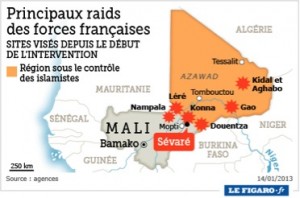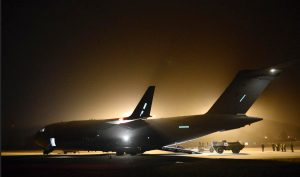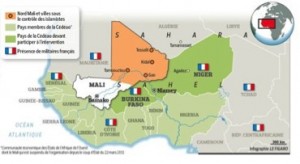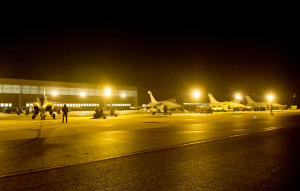By Murielle Delaporte
2013-01-17- Paris, France
This photo was shot in early morning of January 13, 2013
and show four Rafales which took off from the air base at Saint Dizier, France,
with the aim of striking the training camps, infrastructure and logistics support of the rear bases of terrorist groups.
Credit: French Ministry of Defense
The serval is an African wildcat known for his speed and ability to hunt night and day. As the French military enters its seventh day of battle in Mali, the question most frequently asked by the French media has to do with the potential length of an intervention done at the request of Mali’s government. The government of Mali asked for help because Djihadist groups, which were already occupying the Northern part of the country, were taking Konna. This city is close to Mopti, which was considered the last barrier before Bamako was threatened.
Even though such a question is nearly impossible to answer given the nature of warfighting (and in many cases should not be answered for deterrence purpose), the speed of victory will be as always the result of three things: the goals being pursued (what is “victory”?); the threat being faced; and the means made available.
The Goals
At the request of interim President Dioncounda Traoure, France intervened on January 11th to support Mali’s armed forces and protect its 5000 French citizens present in the country against the Djihadist breakthrough towards the South of the country.
The first phase of the intervention has been to pushback the enemy out of Konna and other cities in the area and destroy re-supply potential upper North with the help of air strikes and close air support. Such operations have led the enemy to disperse itself between Gao and Douertza in the East and conduct a counter-offensive in Diabaly in the West. Tombouctou in the upper North, like most big cities occupied till then, was deserted and many logistics and supply depots were destroyed by French air strikes. On Wednesday, the ground war intensified with direct combat and the bombing of moving targets started [1].
The first goal – the first edge of the sword now in progress – is to block further Djihadist progress towards the South against an enemy now in hiding and regrouping.
A clear factor having influenced the timeline of the decision is the six week window of opportunity before the rain season starts.
Achieving the first goal allows for a second goal: to help Mali stabilize itself all over its territory and prevent the Northern part to remain a terrorist safe haven.
Over time, the Northern part of Mali has gradually become a sanctuary at the doorstep of Europe. This has led to the displacing of between 200 000 and 500 000 people in the past years depending on the sources [2].
Eliminating terrorism in the region has been a longstanding goal since the early 21st century. For example, the United States via AFRICOM has been trying to train Mali’s armed forces and other African countries military in order to boost local defenses. But this is easier said than done. There has been slow progress in some cases, setback in others such as the defection of Tuaregs in terrorist ranks and one of the trainees became the author of a putsch against the president of Mali last March [3].
That second goal may last and many observers have drawn comparisons between Mali and Afghanistan.
The Threat
The analogy with Afghanistan is not wrong in many regards given the nature of the enemy and the making of another counter-insurgency war in a territory twice the size of France.
The terrorists are not a homogeneous group, but count three different factions (AQIM [4]; Ansar Dine; Mujao, i.e. the Movement for Oneness and Jihad in West Africa) [5]; their tactics consist in hiding within the population and conduct deadly raids in order to impose the Islamic law (shariah) in the cruelest ways (public amputations and stoning) [6].
The Northern Mali terrorist bastion is also the result of a double spill over from Algeria in the 1990’s with the coming of the Salafists (AQIM comes from the latter and has bases since 2007 in Northern Mali) and from Libya in 2011 with the fleeing of the Tuaregs having fought on the side of Qadhafi bringing with them heavy and sophisticated weaponry [7].

These Djihadists do form a deadly cocktail – modern weaponry and gas supplied via the North African corridor, money from trafficking, training, experience in combat, knowledge of the area – whose determination cannot be questioned. It is important to realize as well that the Tuaregs are pursuing independence for the North (the MNLA calls for a country they call Azawad) : some of them have been pushed aside by AQIM in particular and may want to pursue revenge in a strategic alliance with the Malian armed forces. Indeed the motivation of the groups in presence differs, since AQIM wants to attract a global holy war in the area for years (a “deadly trap” [8] creating an abcess of fixation).
For some observers, the analogy with Afghanistan goes even further with Algeria being the troubled and ambiguous partner for France the way Pakistan has been for the United States towards Afghanistan [9].
Libyan weapons have been flowing via North Africa, especially Algeria, which has been shy in acting against these groups in the past years. Last December’s visit by President Hollande was in part aimed at being on the same page should an intervention occur. To date, Algeria has allowed French fighters to fly over its territory and has agreed to seal its borders with Mali. So did Mauritania.
Tunisia, which is also considered a corridor allowing the flow of military supply to the Islamist rebels, has however not supported Paris. Rafik Abdessalem, the minister of foreign affairs and member of the ruling Islamist party Ennahda, has openly criticized any foreign intervention in the region [10].
This then leads to the question of means to be used in the intervention and support for policy in the region.
The Means
Unlike the serval who is a solitary hunter, France is actively seeking to join forces in this operation and from the outset expressed its willingness to play a buffer role while other troops take over.
Indeed French leadership repeatedly has underscored that, in Laurent Fabius’s words, « France has no vocation to remain in Mali and to fight alone » on the side of the Malian armed forces and has been actively getting the support of the United Nations, European Union, African states, North America and the Gulf States from the outset.
- The first has already been achieved since this intervention had been in the making for a while at that diplomatic level.
- The second may lead to some form of financial support and assistance in training African armies. Hungary has acknowledged that even though Africa is not its area of interest, the issue is global with Djihadists having European passports and may provide 5 to 10 personnel for the training of African soldiers [11]; A few countries may on an individual basis provide more help: the UK has already provided 2 C17s to assist in French Army vehicles transport and Germany may provide some logistic and medical support (although it may take a while given the country’s constitutional constraints requiring a parliamentary vote). However the EU’s March 2011 “Sahel Initiative” has generated significant diplomatic activities, but not much concrete results to stem from, and so far, frustration with the European empty shell is growing in some French circles.
- The third is the triggering of several African nations armed forces (a total of 3300 is expected to arrive in Mali in the coming days). As Tiéman Hubert Coulibaly, minister of foreign affairs in Mali, recalled when visiting his counterpart in Paris on January 14th, the current military intervention is the application of UN Resolution 2085 adopted last December and the catalyst for ECOWAS nations (Economic Communauty of Western African States) to move from a political process into action [12]. One of the concerns is the degree of readiness of many of these troops, except for Nigerian armed forces, which are taking the lead.
- Canada and the United States are there as well, with the latter providing transportation, communication and intelligence assistance (including probably some ISR drones) as well as air to air refueling.

- Finally, President Hollande’s planned visit to the UAE on the 15th lost its main economic emphasis to one which has focused on Mali’s priorities. The French forces based in Abbu Dhabbi, which include 700 men and 6 Rafale, are on alert to be deployed if need be.
Indeed, As far as French means are concerned, it should be noted that contrary to the Libyan operation, this intervention has been prepared for a while and the current surge should lead to 2500 men being involved and includes so far:
- 1700 men, including 800 men deployed on the ground in Mali.
- 4 Rafales flew from FAF base Saint-Dizier to then land in N’Djamena.
- 4 Mirage 2000Ds and 2 C135 tankers already intervened coming from the Epervier force structure in nearby Chad, which includes 2 Mirage F1 CR, 6 Mirage 2000D, 3 C135, 1 C130 and 1 C160 Transall [13].
- Men and armored vehicles are also coming from other French bases and operations in Chad, but also Ivory Coast
- Army helicopters (one pilot from the 4eRHFS was indeed killed the first day after being injured by artillery fire directed against its Gazelle, less protected than the Tigre for that matter).
In this case the ability to rely on a set of French pre-deployed forces in Africa is a tremendous asset, given the fact that there are continuing weaknesses in military capabilities such as airlift [14] (British C17s and leased Antonovs supplement French capabilities, such as the ET Esterel Airbus A310s and A340s [15]) and air refueling. The A330 MRTT is desperately needed as even the United States are showing signs of stretch on this front and may not always be in a position to help out.
The 2008 “Livre Blanc” was advocating a concentration of means in only two bases located on each shore, but at this point French forces are currently organized to support the four big African regional organizations [16].
Source : French forces are split following the four African regional organizations
http://www.senat.fr/rap/r10-324/r10-324_mono.html
The Challenges
The upcoming challenges are numerous not only in Mali, but in the neighboring countries, as well as on European soil and France has been increasing the level of its homeland security plan called «Vigipirate» to the red level again.
Recently a terrorist network aiming at fomenting actions on both French and Malian territories has been dismantled in France. But a new kidnapping by Al Qaida In Maghreb already occurred on the 16th of January at a BP oil facility in Southern Algeria as a retaliation and willingness to enlarge the ‘deadly trap”.

Meanwhile, the failed hostage rescue operation attempted by French special forces (an unusual mix of armed forces and DGSE special forces) in Somalia the same night the intervention in Mali started shows again, if it was necessary, how difficult such missions can be. Reliable intelligence is the key. In this case a scenario similar to the premises of the 1993 Black Hawk Down debacle has been stressed, whereby the noise of helicopters landing 3 kilometers from the site of detention allowed locals to warn the Somalian Islamist Shebabs who retaliated heavily causing the death of one of the French soldier and the capture of another. The latter was later shown dead on a twittered video most French news media fortunately refused to broadcast).
Lasting long enough to achieve such a challenging and long-term mission is of course the major difficulty and that is the reason why working cost-effectively and efficiently in ad hoc coalitions is more than ever needed, even though the coming end of the Afghan tunnel may have given false hopes towards a military pause.
This is especially true at a time when repeated and recently renewed budget cuts and a sustained operational tempo in the past decade have already hurt the countries trying to curtail the threat.
*** Murielle Delaporte is Co-Founder of Second Line of Defense and is Editor-in-Chief of Soutien, Logistique et Defense. A frequent theme of the journal is upon expeditionary logistic.
——-
Graphic credits
Credit for First Graphic: http://www.lefigaro.fr/international/2013/01/13/01003-20130113ARTFIG00184-pourquoi-la-france-a-passela-vitesse-superieure-au-mali.php.
Credit for the Second Graphic: http://www.lefigaro.fr/international/2012/11/11/01003-20121111ARTFIG00194-une-force-africaine-pour-le-nord-du-mali.php
Footnotes
[1] See for instance: http://214.14.134.30/ebird2/ebfiles/e20130115914175.html
[2] The draught is another cause for this population movement : the UN estimates at 30 000 the people having fled the fighting in Mali (http://www.guardian.co.uk/world/2013/jan/15/mali-french-air-strikes)
[4] AQIM is led by Algerians and is linked to the Benghazi attacks according to US officials (http://edition.cnn.com/2012/10/21/world/africa/mali-q-a/index.html)
[6] A Malian witness of the raid done on Konna by the rebels which prompted Mali’s request for France’s military assistance explained that the former arrived in town via regular buses and unveiled their weapons once they set foot in the middle of the population (TF1 news, January 15th, 2013)
[7] See: Mark Doyle, BBC News on Mali (http://www.bbc.co.uk/news/world-africa-21041457)
[9] See the excellent analysis by http://www.lefigaro.fr/international/2013/01/14/01003-20130114ARTFIG00682-conflit-au-mali-le-soutien-de-l-algerie-sera-crucial.php
[10] La voix singulière de la Tunisie critique l’intervention française http://www.lefigaro.fr/international/2013/01/15/01003-20130115ARTFIG00673-la-france-se-retrouve-seule-dans-la-bataille-malienne.php).
[11] http://www.bruxelles2.eu/zones/sahel/la-hongrie-participera-a-loperation-eutm-mali.html
[12] Soir 3, January 14th 2013.
[13] http://www.defense.gouv.fr/operations/mali/actualite/operation-serval-montee-en-puissance-du-dispositif-et-poursuite-des-operations ; http://www.defense.gouv.fr/operations/actualites/mali-operation-serval-poursuite-du-deploiement-des-forces
[14] Another key link is at last coming into place for French expeditionary operations, namely the new airlifter, theA400M (https://sldinfo.com/the-first-french-a400m-rolls-out/)
[15] In the most recent issue of Soutien Logistique Défense, there was a special focus upon French forces in Afghanistan and was based on Delaporte’s visit last Summer to the French troops. The same FAF squadron – ET esterel – which lifted French troops to Afghanistan is not surprisingly the same one which operated in Mali. For a PDF of the article see the following: En Route pour Douchanbe.
[16] See the 2011 Senate report: http://www.senat.fr/rap/r10-324/r10-324_mono.html


